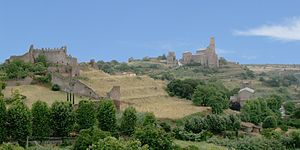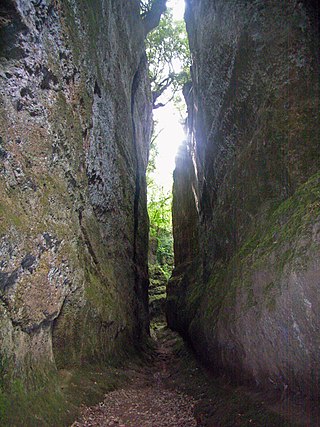
Arezzo is a city and comune in Italy and the capital of the province of the same name located in Tuscany. Arezzo is about 80 kilometres southeast of Florence at an elevation of 296 metres (971 ft) above sea level. As of 2022, the population was about 97,000.
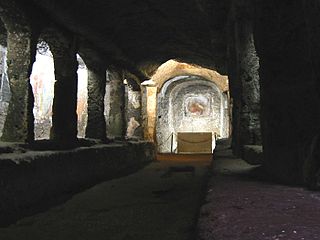
Sutri is an Ancient town, modern comune and former bishopric in the province of Viterbo, about 50 kilometres (31 mi) from Rome and about 30 kilometres (19 mi) south of Viterbo. It is picturesquely situated on a narrow tuff hill, surrounded by ravines, a narrow neck on the west alone connecting it with the surrounding country. It is a member of the I Borghi più belli d'Italia association.

The Province of Terni is the smaller of the two provinces in the Umbria region of Italy, comprising one-third of both the area and population of the region. Its capital is the city of Terni. The province came into being in 1927, when it was carved out of the original unitary province of Umbria.

The Via Clodia was an ancient high-road of Italy. Situated between the Via Cassia and the Via Aurelia, it is different from them notably in that the latter was designed primarily for military long-haul, irrespective of settlements they met, but the Via Clodia was of short-range, intended for commercial traffic with the colonies in Etruscan lands.
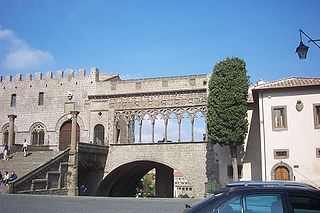
Viterbo is a province in the Lazio region of Italy. Its capital is the city of Viterbo.

Tarquinia, formerly Corneto, is an old city in the province of Viterbo, Lazio, Central Italy, known chiefly for its ancient Etruscan tombs in the widespread necropoleis, or cemeteries, for which it was awarded UNESCO World Heritage status.
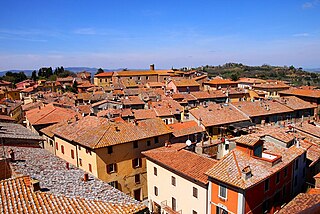
Chiusi is a town and comune in the province of Siena, Tuscany, Italy.
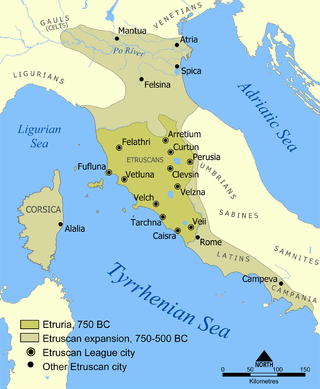
Caere is the Latin name given by the Romans to one of the larger cities of southern Etruria, the modern Cerveteri, approximately 50–60 kilometres north-northwest of Rome. To the Etruscans it was known as Cisra, to the Greeks as Agylla and to the Phoenicians as 𐤊𐤉𐤔𐤓𐤉𐤀.
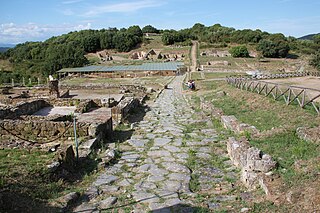
Rusellae was an important ancient town of Etruria, which survived until the Middle Ages before being abandoned. The impressive archaeological remains lie near the modern frazione or village of Roselle in the comune of Grosseto.

Acquapendente is a city and comune in the province of Viterbo, in Lazio (Italy). Acquapendente is a centre for the agricultural production of vegetables and wine, and has a tradition of pottery craftsmanship. Its frazione of Torre Alfina is a member of the I Borghi più belli d'Italia association.

Orte is a town, comune, former Catholic bishopric and Latin titular see in the province of Viterbo, in the central Italian region of Lazio, located about 60 kilometres (37 mi) north of Rome and about 24 kilometres (15 mi) east of Viterbo.
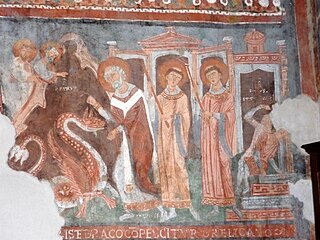
Ceri is a hamlet (frazione) of the comune of Cerveteri, in the Metropolitan City of Rome, Lazio. It occupies a fortified plateau of tuff at a short distance from the city of Cerveteri.

Capranica is a comune (municipality) in the Province of Viterbo in the Italian region Lazio, located about 55 kilometres (34 mi) northwest of GRA, 66 kilometres (41 mi) from Rome’s centre, and 24.5 kilometres (15.2 mi) southeast of Viterbo.

Sovana is a small town in southern Tuscany, Italy, a frazione of Sorano, a comune in the province of Grosseto. It is a member of the I Borghi più belli d'Italia association.
The Fanum Voltumnae was the chief sanctuary of the Etruscans; fanum means a sacred place, a much broader notion than a single temple. Numerous sources refer to a league of the "Twelve Peoples" (lucumonies) of Etruria, formed for religious purposes but evidently having some political functions. The Etruscan league of twelve city-states met annually at the Fanum, located in a place chosen as omphalos, the geographical and spiritual centre of the whole Etruscan nation. Each spring political and religious leaders from the cities would meet to discuss military campaigns and civic affairs and pray to their common gods. Chief amongst these was Voltumna, possibly state god of the Etruria.

The Diocese of Viterbo is a Latin Church ecclesiastical territory or diocese of the Catholic Church in central Italy. From the 12th century, the official name of the diocese was the Diocese of Viterbo e Tuscania. In 1986, several dioceses were combined, and the title was changed to "Diocese of Viterbo, Acquapendente, Bagnoregio, Montefiascone, Tuscania and San Martino al Monte Cimino"; in 1991 the name was shortened to "Diocese of Viterbo".

Acquapendente Cathedral is a Roman Catholic cathedral, dedicated to the Holy Sepulchre, in the town of Acquapendente in Lazio, Italy. Formerly the episcopal seat of the Diocese of Acquapendente, it is now a co-cathedral in the Diocese of Viterbo.
The Diocese of Tuscanella was a Latin Church residential bishopric of the Catholic Church, in existence by the 7th century. Even at the time of the Lombard invasions, it belonged to the Duchy of Rome and was immediately subject to the Pope. The seat of the bishop was originally in the church of S. Maria, then in the church of S. Pietro, and after 1592 in the church of S. Giacomo.

Santa Maria Maggiore is an ancient Romanesque basilica church located at the foot of Colle di San Pietro in Tuscania, Province of Viterbo, Region of Lazio, Italy. Atop the hill is the Basilica of San Pietro.
